It’s not that long ago since Mark Farmer published his detailed review of the UK Construction Labour Model entitled ‘Modernise or Die’. A few months later, a new and extremely informative Global Construction Survey came in public. Its title is ‘Make it or Break it: Reimagining governance, people and technology in the construction industry’. It provides some truly valuable insights on how the building sector can tackle the serious productivity, fragmentation and external competition problems that it is currently facing.
Authors of this enlightening report are Geno Armstrong (Global Sector Leader, Engineering and Construction for KPMG International) and Clay Gilge (Major Projects Advisory Practice Lead for KPMG in the United States). The construction industry is traditionally a slow industry in terms of change and digitization. In that sense, it’s very promising to see that people with great experience in construction, such as Armstrong and Gilge, are addressing the vital issue of improving industry’s performance.
[clickToTweet tweet=”Making or breaking your project depends on three elements: governance, technology and the human touch” quote=”Making or breaking your project depends on three elements: governance, technology and the human touch ️”]
What the numbers say
Coming up with a functional long-term strategy for regaining control over construction projects isn’t easy. This can be seen on the main findings of the ‘Make it or Break it’ survey, as well. First things first, the central question of the whole research is the following:
“How can the construction and engineering industry overcome inconsistent performance, external competition and fragmentation by reinventing its approach to governance, people and technology?”
Addressing those three components (governance, people, technology) together and finding the required harmony between them could be the secret for a more efficient and well-functioning construction industry. In order to achieve this, there are certain crucial parameters that have to be taken into consideration.
Administration pains
The completion of capital projects is undoubtedly one of them. The vast majority of the surveys’ participants (above 80%) expressed their certainty that their organization was able to complete projects without exceeded the agreed deadlines and budget. On top of that, 92 per cent of the respondents were very confident that their system can generate portfolio and project reporting in an accurate and timely manner. And this is where an interesting paradox is emerging. Only 25 per cent believe that the construction industry has managed to establish an efficient system in terms of project delivery performance. Furthermore, 50 per cent of the participants admitted that problematic project performance has negatively affected their construction firm during the last three years.
Read also: Up to 7% savings on construction projects run using GenieBelt
Project delivery is inextricably linked to project reporting. As you can see on the graph below, only 8 per cent of the executives asked replied that their company has adopted a “push-one button, real-time fully functional PMIS (Project Management Information System) reporting”. And that’s not all, as not more than 31 per cent has implemented integrated platforms for project scheduling.
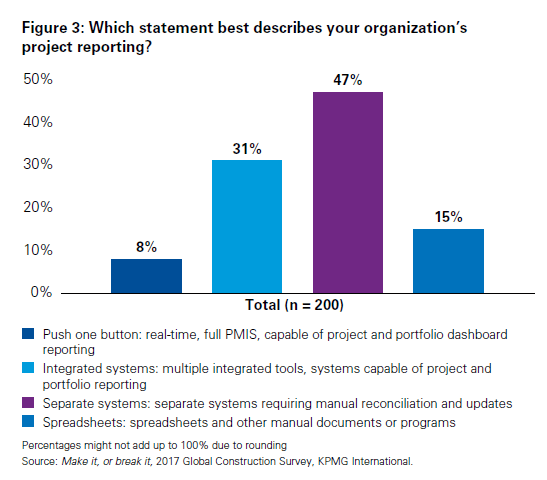
The human touch
Contractors, regardless of their size, need to make sure that they take the best out of their workforce. This is an extremely crucial parameter that should never be ignored. The biggest challenge, in this case, is finding a good balance between the various employees, given their diversity both in terms of age and societal background. In that way, the individuals will be able to successfully support the established construction project and contribute to its optimization.
Find here: This is the key to unlocking efficiency on site
The importance of the prior mentioned remarks becomes even bigger if we take into account that 40 per cent of the people working in construction are Gen X, while 37 per cent are Millennials. What’s more interesting, though, is that according to a significant number of the survey participants (24%) Millennials have serious difficulties in understanding the core ideas of project delivery.
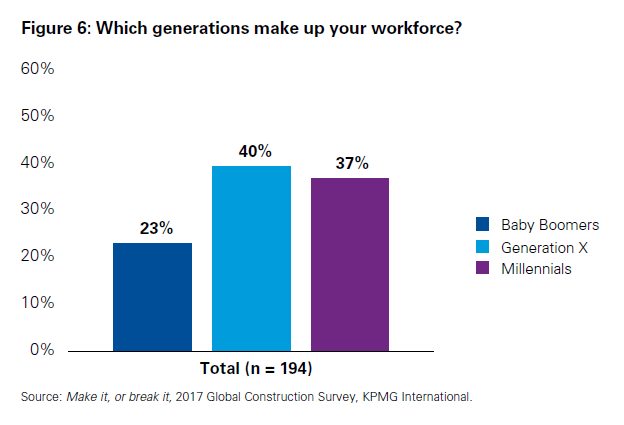
The technological breakthrough
Investing in the right technologies can truly make a difference in the effort of the construction industry to raise the bar on project performance. That being said, the fact that 72 per cent of the survey participants considers innovation and data as an integral part of their strategic vision can be regarded as a step in the right direction. Nevertheless, 45 per cent still believes that the construction industry isn’t mature enough for technological disruption.
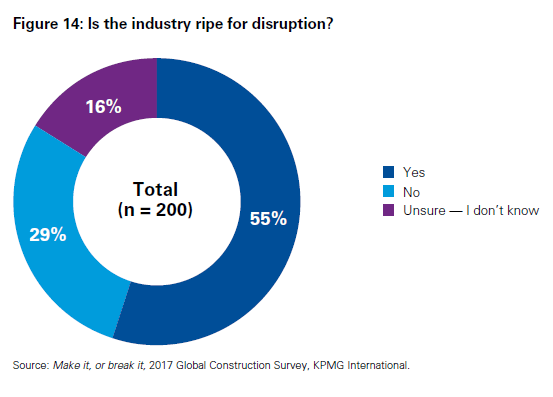
To make matters worse, just 20 per cent of respondents answered that their organizations have already put into action a Project Management Information System (PMIS) across all of their projects. That comes as no surprise if we take into consideration that 52 per cent of the respondents hasn’t developed an accurate data strategy and that only 5 per cent of the surveyed companies regard themselves as “cutting edge” in terms of technological maturity.
These numbers prove that the construction industry hasn’t fully realized how vital data-driven decision making can be and how much it can add in terms of transparency and project efficiency.
Three steps to empowering performance in construction
By now, it’s evident that the construction industry has to become better in integrating the components mentioned before. In that manner, the goal of boosting project performance and innovation can be attained.
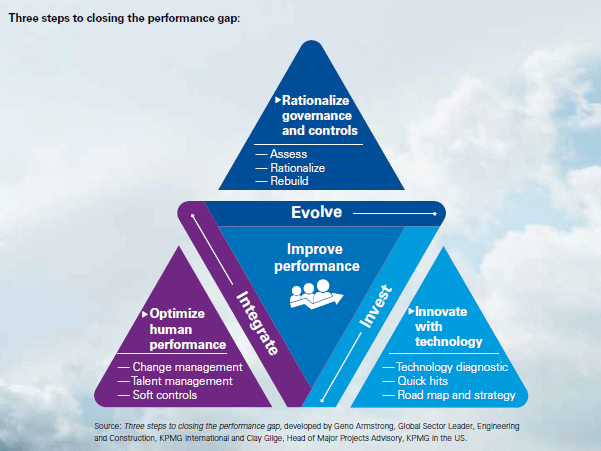
In a nutshell, here are the three steps that the building sector needs to take in order to overcome the ongoing performance crisis:
1. Rationalize controls and governance
First and foremost, contractors and owners have to come up with a smart plan in order to add some structure to their projects. The lack of real-time updates is hurting efficiency and leads to more complicated and risky construction projects. Due to this problematic reality, project controls are becoming more and more perplexed and ineffective. For that reason, the following three-step plan is more than necessary:
- Assess: Before you do anything else, it’s indispensable that you assess your existing control and administration processes and look for design or efficiency flaws on the existing system.
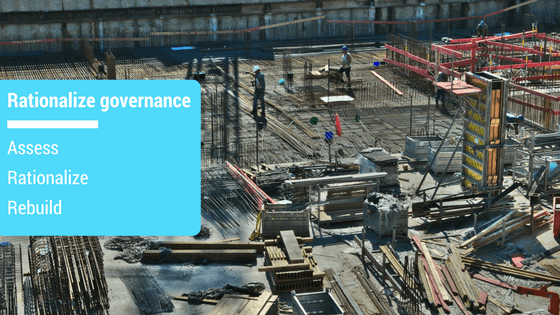
- Rationalize: Now that the overall assessment is over, you are ready to closely examine particular controls and processes and come up with the changes that should be done. Try to engage employees from different ages and backgrounds in an endeavor to acquire a complete picture of the existing hiccups.
- Rebuild: Last but certainly not least, start rebuilding your long-term strategy in a way that allows for the overall amelioration of the project environment and for further investment in innovative technologies.
Invest in technological innovation
Establishing a well-functioning governance plan is one thing. Investing in it through new technologies is another. Digital technologies are already transforming construction (eg. real-time project management) and in that sense focusing on how you can take the best of their use for your project is the only way forward:
- Establish a data diagnostic: The better you understand the available data and technologies around your project, the higher benefit you can have for your company. That’s why, you need to build a practical process which will help you understand where you should focus your efforts.
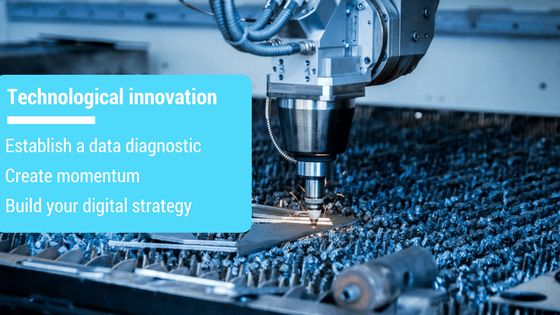
- Create momentum: Some quick smart wins can significantly contribute to your goal of increasing the technological engagement of your company. Thanks to this, you can help your employees establishing faith in digital tools. Moreover, you can show to the younger members of the team that you have an ambitious long-term vision for the firm. Data analytics could be your starting point as it could empower data management and data-driven decision making.
- Build your digital strategy: After acquiring a good comprehension of your technological stage and earning momentum through some quick hits, it’s time to set up your digital strategy. The plan may cover a wide spectrum of technology uses from drones to construction software. But you have to be really careful in establishing a strategy that can easily be aligned with your broader business roadmap.
Put together a high-functioning workforce
The third and extremely important piece of this efficiency puzzle is, of course, the workforce of the company. The construction industry is accommodating up to four different generations of employees. As a consequence, it’s utterly important that you take the time to develop the skills of your workforce and establish good mutual communication between the numerous individuals who work under the same cause.
- Support an inclusive culture: Building a culture that can be functional for everyone is probably one of your biggest challenges. You have to overcome the natural resistance of the older generations towards change, while at the same time you should build an inspireful place to work for the younger employees. In that way, every member of your team can be on the same page and work effectively.

- Balanced management of the employees: Every generation has different needs to some extent. That’s why, you have to find the right balance when it comes to managing your employees. As a rule, the older the employees the more structured hierarchy they seem to prefer. Au contraire, Millennials and Generation X individuals appear to feel more comfortable when they are working independently. Your mission is to help everyone feel secure and motivated.
- Talent management under the spotlight: Taking your talent management game to the next level is very essential. Having established the ideal business and technology strategy means nothing if you don’t have the right people to work on it. In that aspect, it’s indispensable that you are able to define your exact needs and recruit the most suitable individuals for the job.
The leaders of the digital game
The discussion around digital technologies in construction is getting more and more intense all over the world and it is of great interest to see which countries are leading the technological disruption game in construction. According to the insightful findings of the Global Construction Survey, the answer depends on the type of technology examined.
More analytically, China is showing the way when it comes to advanced data and data analytics. But that’s not all. The Chinese market has a strong presence in Building Information Modeling, too. The United Kingdom is also making a great effort to become a strong BIM player and this can easily be evident by the recent government mandate (all public projects should be undertaken using BIM, starting from 2016). Additionally, mobile platforms, VR and drone technology are used with greater frequency within the British market.
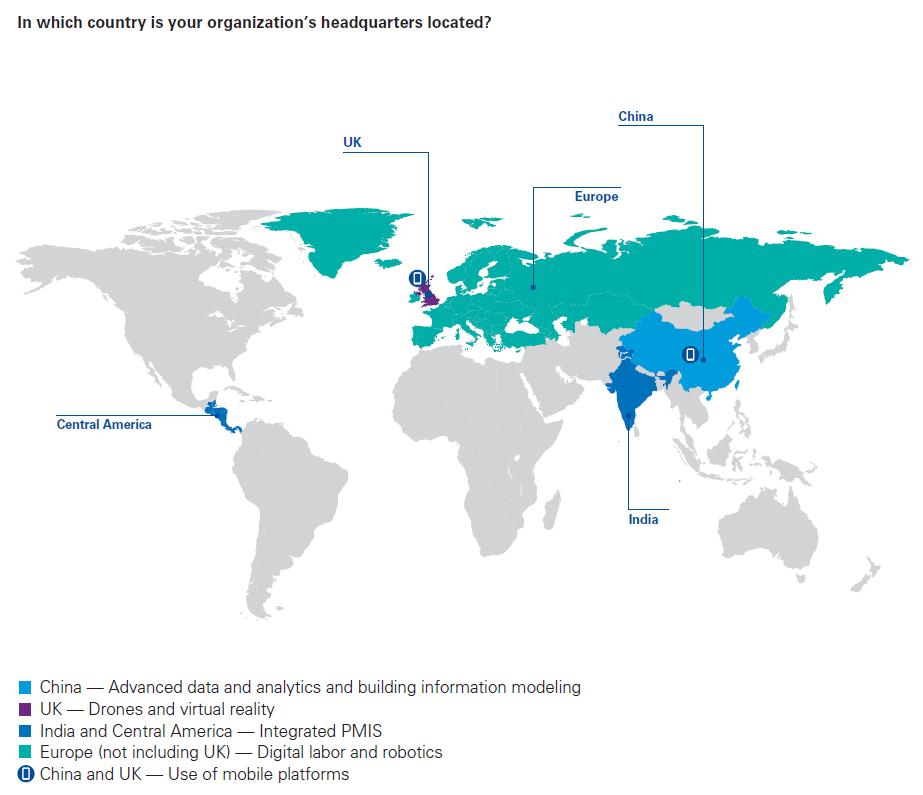
As far as the European market (except the UK) is concerned, digital labor and robotics seem to be its strength points. Lastly, Australia has put a lot of focus on 3D printing, while Central America and India are the thought leaders on integrated Project Management Information Systems (PMIS).
Synopsis
“Making or breaking your construction project” is a result of numerous factors. However, everything at the end of the day comes down to a very specific requirement. The harmonic integration of the industry’s core components: digital technology, human workforce and administration practices. Only then, it will be able for the construction industry to boost efficiency on and off-site.




